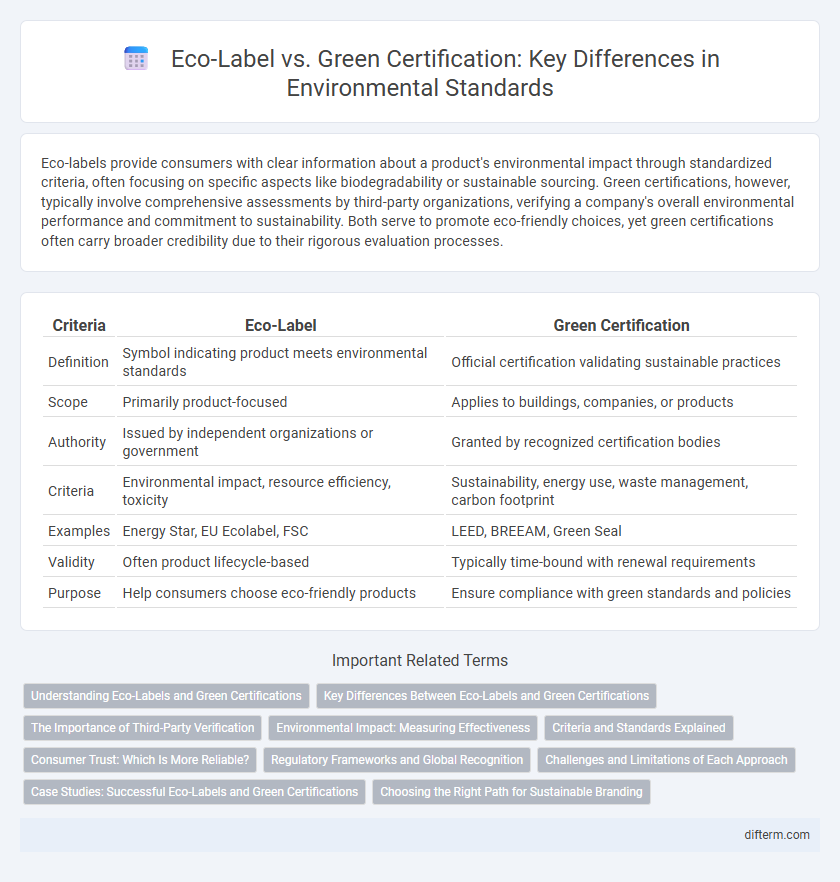Eco-labels provide consumers with clear information about a product's environmental impact through standardized criteria, often focusing on specific aspects like biodegradability or sustainable sourcing. Green certifications, however, typically involve comprehensive assessments by third-party organizations, verifying a company's overall environmental performance and commitment to sustainability. Both serve to promote eco-friendly choices, yet green certifications often carry broader credibility due to their rigorous evaluation processes.
Table of Comparison
| Criteria | Eco-Label | Green Certification |
|---|---|---|
| Definition | Symbol indicating product meets environmental standards | Official certification validating sustainable practices |
| Scope | Primarily product-focused | Applies to buildings, companies, or products |
| Authority | Issued by independent organizations or government | Granted by recognized certification bodies |
| Criteria | Environmental impact, resource efficiency, toxicity | Sustainability, energy use, waste management, carbon footprint |
| Examples | Energy Star, EU Ecolabel, FSC | LEED, BREEAM, Green Seal |
| Validity | Often product lifecycle-based | Typically time-bound with renewal requirements |
| Purpose | Help consumers choose eco-friendly products | Ensure compliance with green standards and policies |
Understanding Eco-Labels and Green Certifications
Eco-labels and green certifications serve as important tools for identifying environmentally responsible products and services. Eco-labels specifically communicate the reduced environmental impact of consumer goods through standardized criteria set by recognized organizations. Green certifications encompass a broader scope, often including sustainable practices in production, resource management, and corporate social responsibility verified by third-party auditors.
Key Differences Between Eco-Labels and Green Certifications
Eco-labels primarily indicate that a product meets specific environmental standards verified by third-party organizations, providing consumers clear information about its eco-friendly attributes. Green certifications, however, often encompass broader criteria including sustainable production processes, resource efficiency, and corporate social responsibility beyond individual products. The key difference lies in eco-labels targeting product-level environmental claims, while green certifications assess overall environmental performance and management systems of companies or facilities.
The Importance of Third-Party Verification
Third-party verification ensures the credibility of eco-labels and green certifications by independently assessing compliance with environmental standards. This impartial evaluation eliminates conflicts of interest and fosters consumer trust in sustainable products. Verified certifications drive market demand for truly eco-friendly goods, promoting industry-wide environmental responsibility.
Environmental Impact: Measuring Effectiveness
Eco-labels directly inform consumers about a product's verified environmental impact, using transparent criteria such as carbon footprint, water usage, and resource sustainability. Green certifications assess overall organizational practices and processes, often incorporating lifecycle analysis to ensure continuous environmental improvement. Measuring effectiveness relies on standardized metrics and third-party audits to validate reductions in pollution, waste, and resource consumption across supply chains.
Criteria and Standards Explained
Eco-labels are consumer-facing marks that indicate products meeting specific environmental criteria established by governments or independent organizations, focusing on sustainability aspects such as resource use, emissions, and recyclability. Green certifications involve stringent, third-party verified standards that assess broader environmental impacts, including lifecycle analysis, energy efficiency, and waste reduction, ensuring compliance with international or industry-specific benchmarks. Both systems promote transparency and environmental responsibility, but green certifications often require more comprehensive, ongoing audits and documented improvements beyond initial product criteria.
Consumer Trust: Which Is More Reliable?
Eco-labels provide consumers with clear, standardized information about a product's environmental impact, often verified by third-party organizations, enhancing transparency and reliability. Green certifications, while also credible, may vary widely in their criteria and rigor, sometimes leading to consumer skepticism due to inconsistencies across industries. Studies show that consumers tend to trust eco-labels more because they offer a consistent and accessible way to evaluate sustainability claims.
Regulatory Frameworks and Global Recognition
Eco-labels and green certifications operate within distinct regulatory frameworks that influence their credibility and enforcement across industries. Eco-labels often follow internationally recognized standards such as ISO 14024, ensuring consistent environmental criteria and market transparency. Green certifications, governed by regional or national regulations, sometimes face variability in acceptance, impacting their global recognition and trade benefits.
Challenges and Limitations of Each Approach
Eco-labels often face challenges related to consumer awareness and trust, as inconsistent criteria and lack of standardization can confuse buyers. Green certifications may have limitations due to the high costs and complex processes required for businesses to achieve compliance, which can exclude smaller enterprises. Both approaches struggle with ensuring transparency, preventing greenwashing, and maintaining rigorous updates to reflect evolving environmental standards.
Case Studies: Successful Eco-Labels and Green Certifications
Case studies reveal that eco-labels like the Forest Stewardship Council (FSC) have significantly advanced sustainable forestry by promoting responsible resource management and consumer awareness. In parallel, green certifications such as LEED (Leadership in Energy and Environmental Design) have driven energy-efficient building practices, resulting in measurable reductions in carbon emissions and operational costs. These success stories highlight the effectiveness of both eco-labels and green certifications in fostering environmental stewardship across industries.
Choosing the Right Path for Sustainable Branding
Eco-labels and green certifications both serve as credible indicators of environmental responsibility, but eco-labels often focus on specific product attributes like organic or recyclable content, while green certifications assess broader organizational practices and compliance with rigorous sustainability standards. Selecting the right path for sustainable branding depends on aligning the chosen label or certification with your company's environmental goals, target audience, and market sector to maximize authenticity and consumer trust. Leveraging recognized eco-labels or comprehensive green certifications can enhance brand reputation, drive eco-conscious consumer behavior, and support long-term environmental commitments.
eco-label vs green certification Infographic

 difterm.com
difterm.com